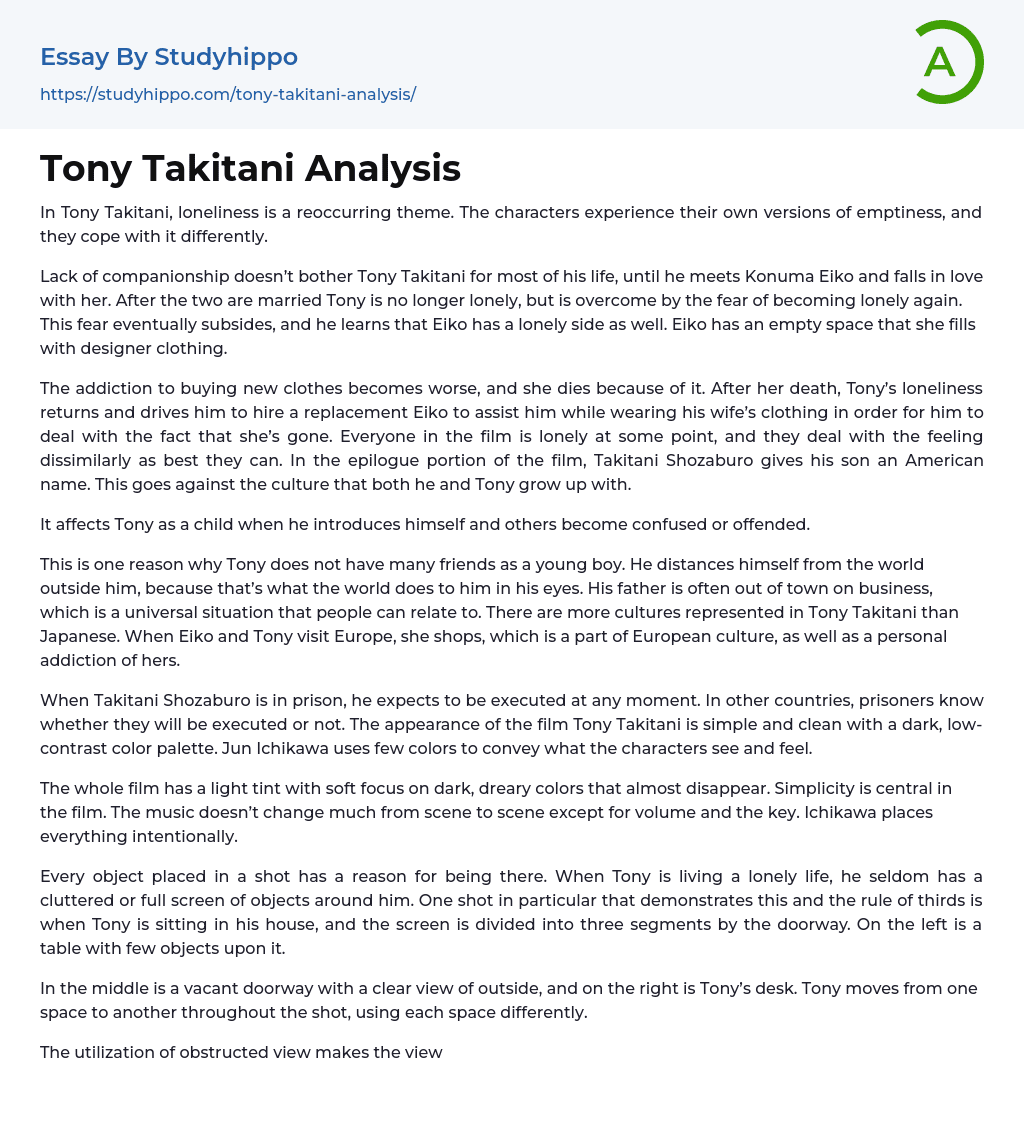In Tony Takitani, loneliness is a reoccurring theme. The characters experience their own versions of emptiness, and they cope with it differently.
Lack of companionship doesn’t bother Tony Takitani for most of his life, until he meets Konuma Eiko and falls in love with her. After the two are married Tony is no longer lonely, but is overcome by the fear of becoming lonely again. This fear eventually subsides, and he learns that Eiko has a lonely side as well. Eiko has an empty space that she fills with designer clothing.
The addiction to buying new clothes becomes worse, and she dies because of it. After her death, Tony’s loneliness returns and drives him to hire a replacement Eiko to assist him while wearing his wife’s clothing in order for him
...to deal with the fact that she’s gone. Everyone in the film is lonely at some point, and they deal with the feeling dissimilarly as best they can. In the epilogue portion of the film, Takitani Shozaburo gives his son an American name. This goes against the culture that both he and Tony grow up with.
It affects Tony as a child when he introduces himself and others become confused or offended.
This is one reason why Tony does not have many friends as a young boy. He distances himself from the world outside him, because that’s what the world does to him in his eyes. His father is often out of town on business, which is a universal situation that people can relate to. There are more cultures represented in Tony Takitani than Japanese. When Eiko and Tony visit Europe, she shops,
which is a part of European culture, as well as a personal addiction of hers.
When Takitani Shozaburo is in prison, he expects to be executed at any moment. In other countries, prisoners know whether they will be executed or not. The appearance of the film Tony Takitani is simple and clean with a dark, low-contrast color palette. Jun Ichikawa uses few colors to convey what the characters see and feel.
The whole film has a light tint with soft focus on dark, dreary colors that almost disappear. Simplicity is central in the film. The music doesn’t change much from scene to scene except for volume and the key. Ichikawa places everything intentionally.
Every object placed in a shot has a reason for being there. When Tony is living a lonely life, he seldom has a cluttered or full screen of objects around him. One shot in particular that demonstrates this and the rule of thirds is when Tony is sitting in his house, and the screen is divided into three segments by the doorway. On the left is a table with few objects upon it.
In the middle is a vacant doorway with a clear view of outside, and on the right is Tony’s desk. Tony moves from one space to another throughout the shot, using each space differently.
The utilization of obstructed view makes the viewer wonder what he or she is missing. It creates mystery and different points of view. Often the camera is focused on the feet of Eiko which shows her vast shoe collection and the way she walks, but not her complimenting outfit. Icikawa’s use of actor’s is ironic
and effective to the point of the film and the characters’ stories.
He uses the same actor for Konuma Eiko and Hisako and does the same for both Tony Takitani and his father, Takitani Shozaburo.
Tony attempts to replace Eiko with Hisako by providing her with Eiko’s clothing. There are reflections of Shozaburo in Tony throughout the film. While he is playing trombone on stage, the camera cuts back and forth from him to Tony.
At the beginning viewers see him lying in his prison cell with his back to the screen, and near the end there is a shot of Tony lying the same way in his own cell—Eiko’s former dressing room. Though they are played by the same actors, both sets of characters represent the same people, but aren’t the same to the people around them.
- John Locke essays
- 9/11 essays
- A Good Teacher essays
- A Healthy Diet essays
- A Modest Proposal essays
- A&P essays
- Academic Achievement essays
- Achievement essays
- Achieving goals essays
- Admission essays
- Advantages And Disadvantages Of Internet essays
- Alcoholic drinks essays
- Ammonia essays
- Analytical essays
- Ancient Olympic Games essays
- APA essays
- Arabian Peninsula essays
- Argument essays
- Argumentative essays
- Art essays
- Atlantic Ocean essays
- Auto-ethnography essays
- Autobiography essays
- Ballad essays
- Batman essays
- Binge Eating essays
- Black Power Movement essays
- Blogger essays
- Body Mass Index essays
- Book I Want a Wife essays
- Boycott essays
- Breastfeeding essays
- Bulimia Nervosa essays
- Business essays
- Business Process essays
- Canterbury essays
- Carbonate essays
- Catalina de Erauso essays
- Cause and Effect essays
- Cesar Chavez essays
- Character Analysis essays
- Chemical Compound essays
- Chemical Element essays
- Chemical Substance essays
- Cherokee essays
- Cherry essays
- Childhood Obesity essays
- Chlorine essays
- Classification essays
- Cognitive Science essays




